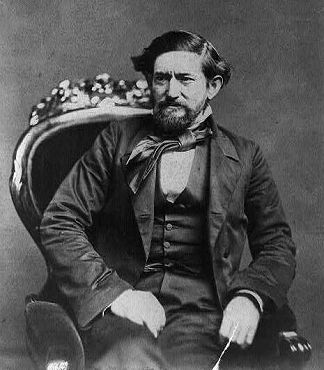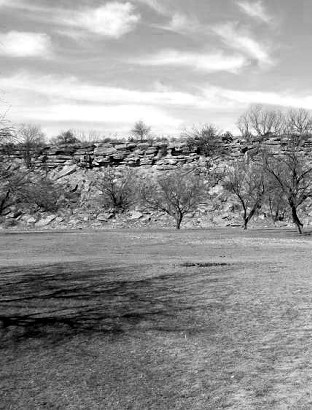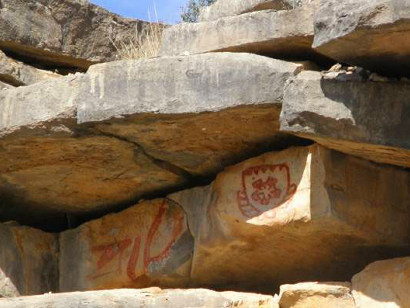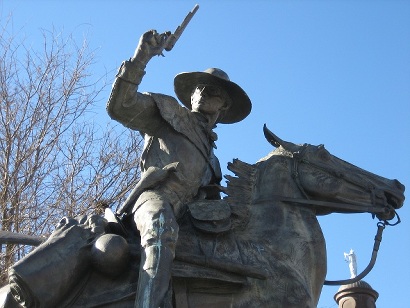|
Books by
Jeffery Robenalt
|
|
In
July 1845, after the Congress of the Republic of Texas approved
the terms of annexation offered by the United States government,
President James K. Polk dispatched General Zachary Taylor and 5000
Federal troops to the small Texas settlement of Corpus
Christi at the mouth of the Nueces River. According to the Mexican
government, the Nueces was, and always had been, the border between
Mexico and the province of Texas. However, based on the Treaties
of Velasco, signed by Santa Anna after the Texas Revolution,
the Texans insisted the border was the Rio Grande.
In late December, the United States Congress officially recognized
the Rio Grande River as the border. General Taylor then prepared
to move his troops south into the land that stretched between the
Rio Grande and the Nueces known as the Nueces Strip; an act that
would eventually initiate hostilities between the United States
and Mexico. The Texas Rangers were long familiar with the lawless
Nueces Strip, and Captain Jack Hays rode to Corpus
Christi to offer the services of his Rangers to act as scouts
for the American Army, who in 1845 lacked a cavalry branch and depended
on slow-moving, mounted infantry known as dragoons to provide mobility.
|
 |
Portrait
of Jack Hays
Wikimedia Commons |
|
While Jack Hays
was presenting his offer to General Taylor, he received word of
a large Comanche war party putting the torch to the settlements
southwest of San Antonio.
Knowing that he could never catch the elusive Comanches by following
their trail, Hays quickly returned to San
Antonio, and after gathering up forty Rangers and a few Tonkawa
and Lipan Apache scouts, rode hard for Enchanted Rock, a well-known
Indian landmark northwest of the old mission town. In this way,
the veteran Captain of Rangers hoped to intercept the war party
before the warriors could escape into the far reaches of the Comancheria.
|
Comanche
Portraits
wikipedia |
|
Hays and his
Rangers reined up at Enchanted
Rock early the following morning only to find that they had
barely missed the Comanches, but the Indian scouts soon found a
fresh trail heading off to the northwest. A severe drought had long
plagued the area, and the scouts were sure that a small lake formed
by the nearly dry Concho River would serve as the only watering
hole in that direction for miles around. The lake stood at the base
of Paint Rock in present day Concho
County. Based on this information, Hays made a fateful decision.
Facing odds of more than ten to one, the Rangers set out to beat
the Comanches to the water.
Forty-two hours and 130 miles of hard, bone-jarring riding later,
Jack Haysís weary Rangers did exactly that, reaching the lake at
1:00 in the morning, well ahead of the unsuspecting Comanches. After
ordering the picketing of the horses to the rear, Hays carefully
concealed his men in a willow thicket along the north shore; the
only approach to the water. On the south rim, the face of Paint
Rock rose high above the shimmering moonlit surface of the lake.
|
 |
|
As expected,
the war party approached the lake at dawn, thirsty, saddle-weary,
and anxious to rest for the remainder of the day. Hays let the warriors
get as close as possible to the willow thicket before giving the
command to open fire. Smoke and fire billowed out of the willows
with the roar of the Rangersí rifles, and the Comanches fell back
in disarray, carrying off as many of their dead as they could. However,
a few alert warriors spotted the Rangersí trail as they rode out
of range. The tracks clearly showed there were no more than thirty
or forty riders concealed in the thicket. With their superior numbers,
the Comanches believed they could easily overwhelm the Rangers in
the full light of the new day.
The first Comanche attack would come rolling out of the northeast,
ensuring that the blinding glare of the rising sun would shine directly
in the Rangersí eyes. With their short bows, long war lances, and
buffalo hide shields tough enough to turn a rifle ball, the Comanches
presented a fearsome spectacle as they assembled for the charge.
The war chief, feathers and colored ribbons fluttering in the breeze,
lowered his long, scalp-decorated war lance, and the warriors suddenly
broke into a screaming, galloping mass of color.
Hays fired when the Comanches closed to within fifty yards, and
the Rangers quickly joined in with a thunderous volley. Galloping
past the willow thicket, the warriors released a barrage of arrows
as they slid off to the sides of their horses to avoid the deadly
Ranger rifle fire. Circling wide, the Comanches made a second charge
past the thicket before pulling back to regroup for a lance charge
that the Rangers quickly broke with the brutal firepower of their
rapid firing Colt revolvers and muzzle-loading shotguns.
The Comanches made several more gallops past the thicket throughout
the remainder of the day before finally withdrawing to the prairie
and setting up camp for the night. By now they were growing so desperate
for water they were forced to send warriors in relays for more than
twenty miles to get it.
Late the following morning, the Comanches launched a massive attack
in four separate waves, the first waves attempting to get the Rangers
to empty their weapons, so the later waves could close in. A few
warriors in the final wave managed to crash their way into the thicket,
war lances lowered, but they were again blasted off the backs of
their painted ponies by the Rangers superior firepower.
|
 |
|
Withdrawing
to the top of Paint Rock, the Comanches spent the remainder of the
day firing arrows high into the air, attempting to arch them into
the willow thicket. The arrows were ineffective from such long range,
but the Ranger rifles managed to chalk up a few more Comanche victims
who carelessly exposed themselves on the rim of the high rock. As
the sun began to set, the frustrated warriors again withdrew to
the prairie, their thirst unquenched.
Early in the morning of the third day the Comanches attacked the
Texans from several different angles at once, forcing the defenders
to divide their fire. Realizing from the diminished volume of gunfire
coming from the thicket that the Rangers were running low on powder
and ball, the war chief took his time, massing his warriors on the
high ground to the northeast for one final attack that would surely
overwhelm the beleaguered defenders.
By mid-morning all was ready and the war chief rode to the front
of his warriors, raising his war lance high and haranguing the Comanches
into making one final supreme effort. Screaming his fury, the Comanche
leader heeled his stallion to a gallop and led what was to be the
final charge at the willow thicket. The Rangers calmly picked out
targets over the sights of their long rifles and took up the slack
in their triggers, waiting patiently for Hays to open fire and swallowing
the fear that churned their bellies as the painted warriors drew
closer.
Hays had been trying to get a decent shot at the Comanche leader
since the fighting had begun, and at less than a hundred yards he
finally got his chance, when the war chief made a fatal mistake
by turning on the back of his galloping pony to urge his warriors
on. As he swung around, the Comancheís buffalo hide shield turned
with him, exposing his right side. Jack Hays chose that instant
to open fire, and the war chief was dead before his body struck
the tall grass of the prairie.
The untimely death of the war chief shattered the momentum of the
charge, and a terrible wail of anguish arose from 600 Comanche throats
as the warriors milled around in front of the thicket. Before the
Comanches could recover their momentum, Rangers up and down the
line opened fire with a rolling volley of thunder. The leaderless
warriors retreated as several more painted ponies were emptied.
Hays ordered one of his men to ride out, rope the war chiefís neck,
and drag the body back to the Ranger lines. This act of defiance
infuriated the Comanches, and they galloped past the thicket one
final time, launching a cloud of arrows before riding away in frustration
to the northwest toward for the Comancheria.
|
 |
|
The
Battle of Paint Rock was a resounding victory for the Texas Rangers.
More than 100 Comanche dead lay strewn across the prairie in front
of the willow thicket. Incredibly, only one Ranger had been wounded
in the fighting, and one unlucky horse killed by an arrow launched
from the rim of Paint Rock. With the dawn of the Mexican American
War, Jack Hays would devote the remainder of his Texas Ranger career
serving as a volunteer with the United States Army, riding for both
General Zachary Taylor at Monterey and General Winfield Scott on
the road to Mexico City. Paint Rock was to be his final major engagement
with the Comanches.
Finally, in the absence of official records, some historians have
questioned the truth of the Rangersí victory at Paint Rock, as they
have Jack Haysís efforts at Bandera Pass and his solo fight against
the Comanches at Enchanted Rock. Some have even suggested that Paint
Rock was an attempt to revise history for the sake of tourism dollars
or to ďglorifyĒ the Rangers. However, the Texas Rangers need no
help from me or any other historian to bring glory and honor to
their name. History is, and always will be, an attempt to recount
the distant past, and one manís history is often times another manís
fiction. I choose to believe those like Joe Tom Davis in Volume
IV of Legendary Texans, and Thomas W. Knowles in They
Rode for the Lone Star: The Saga of the Texas Rangers, who believe
in the truth of Paint Rock as I do.
© Jeffery
Robenalt
"A Glimpse of Texas Past"
June
1, 2012 Column
jeffrobenalt@yahoo.com
|
References
for "Paint Rock: The Last Comanche Fight of Jack Hays "
|
|
Austerman,
Wayne R. (2010), Ambush and Siege at Paint Rock, originally
published by Wild West Magazine, published online February 05, 2010,
HISTORYnet.com Weider History Group.
Davis, Joe
Tom (1989), Legendary Texans Vol. IV, Eakin Press, Austin
TX ISBN 0-89015-669-7.
Knowles, Thomas
W. (2009), They Rode for the Lone Star: Saga of the Texas Rangers,
Lone Star Publishing, ISBN 978-09435416.
|
|
|